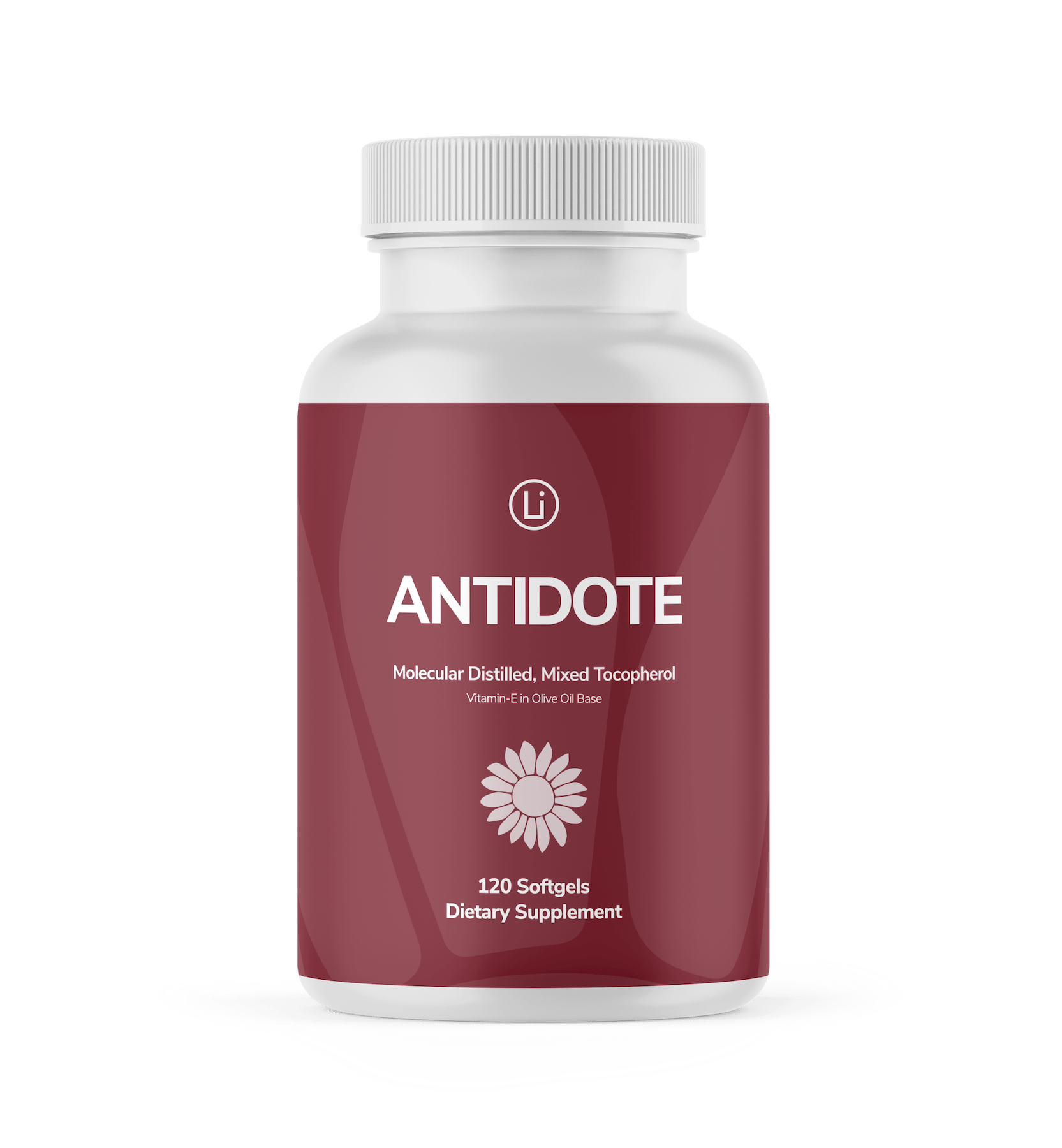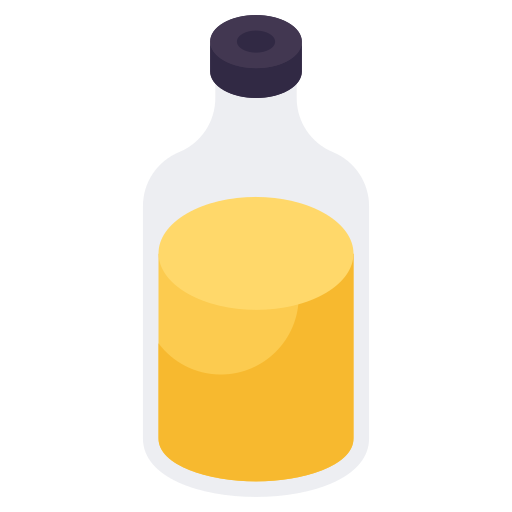Antidote
- Anti-Inflammatory
- Hormone Support
- Thyroid Support
Pure mixed tocopherols, in an organic olive oil base (no fillers/PUFA) with a bovine gelatin softgel capsule. Sourced from non-GMO, organic soy, our product is tested soy-free after our solvent-free extraction of molecular distillation.
- Save 10% on every subscription
- Free shipping in US & Canada over $100
- Cancel/Pause any time
- Helps prevent the oxidation of PUFA*
- Assists in reversing lipofuscin*
- Decreases excess estrogen (inhibits the enzyme aromatase)*
- Promotes weight loss*
- Improves cell waste detoxification*
- Reverses age pigment/liver spots/age spots*
- Increases fertility*
- Helps cells utilize oxygen*
- Mitigate macular degeneration*
- Improves insulin resistance*
*These Statements have not been evaluated by the Food and Drug Association, or Health Canada. These products are not meant to diagnose, treat, cure, or prevent any diseases.
Each bottle contains: 120 bovine softgels
Servings per container: 60
Each 1 softgel contains:
Alpha tocopherol: 134mg
Gamma tocopherol: 150 mg
Delta tocopherol: 50 mg
Beta tocopherol: ~5 mg
Other Ingredients: gelatin (bovine), glycerin, purified water (softgel).
Take 2 capsules daily, with food.
Can also be used topically to heal sunburns, scars or as a facial serum.
1. M. K. Horwitt, Ph.D., Status of human requirements for vitamin E, The American Journal of Clinical Nutrition, Volume 27, Issue 10, October 1974, Pages 1182–1193. sci-hub.se/10.1093/ajcn/27.10.1182
2. Valk EE, Hornstra G. Relationship between vitamin E requirement and polyunsaturated fatty acid intake in man: a review. Int J Vitam Nutr Res. 2000 Mar;70(2):31-42. https://pubmed.ncbi.nlm.nih.gov/10804454/
3. Raederstorff D, Wyss A, Calder PC, Weber P, Eggersdorfer M. Vitamin E function and requirements in relation to PUFA. Br J Nutr. 2015 Oct 28;114(8):1113-22. Epub 2015 Aug 21. https://pubmed.ncbi.nlm.nih.gov/26291567/
4. Bässler KH. On the problematic nature of vitamin E requirements: net vitamin E. Z Ernahrungswiss. 1991 Sep;30(3):174-80. https://pubmed.ncbi.nlm.nih.gov/1763554/
5. Winstanley EK, Pentreath VW. Lipofuscin accumulation and its prevention by vitamin E in nervous tissue: quantitative analysis using snail buccal ganglia as a simple model system. Mech Ageing Dev. 1985 Mar;29(3):299-307. https://pubmed.ncbi.nlm.nih.gov/3990384/
6. Liu M, Wallin R, Wallmon A, Saldeen T. Mixed tocopherols have a stronger inhibitory effect on lipid peroxidation than alpha-tocopherol alone. J Cardiovasc Pharmacol. 2002 May;39(5):714-21. doi: 10.1097/00005344-200205000-00012. PMID: 11973415. https://pubmed.ncbi.nlm.nih.gov/11973415/
*These Statements have not been evaluated by the Food and Drug Association, or Health Canada. These products are not meant to diagnose, treat, cure, or prevent any diseases.
Antidote Background Information
How Vitamin E deficiency begins:
Vitamin E is our primary defense against the damage done by the accumulation and oxidation of both Polyunsaturated Fatty Acids (PUFA) and excess iron in our tissues, blood, and organs.
This is a result of a lifetime of consumption of industrial junk food, such as:
- All fried foods
- Chips, tortillas, crackers (even the ones marketed as 'healthy' that are fried in seed oil)
- Vegetable/Canola/Sunflower/Grapeseed/Safflower/Soybean oil
- Any other nut or seed-derived oil
- Nuts & seeds/ nut butter
- Cereal, granola, snack bars, cookies
- Grocery store (shelf-stable) breads and wraps
- Omega-3 supplements
- Mayonnaise
- Margarine
and lots more (read ingredient labels!)
The more of these foods that you have consumed, the more you have pushed your body into a Vitamin E deficiency [1-4].
Why do these foods cause such damage?
When we eat foods with high amounts of Omega 3 and Omega 6 PUFA, these oils are highly susceptible to oxidation because our bodies contain heat and oxygen.
When these oils oxidize, they form a plastic-like material that clogs up and suffocates our cells! This material is called lipofuscin, a key indicator of cellular aging and damage. You can read about that in detail in our blog post: 'Omega 3's are Toxic'.
Beyond that, it causes a host of breakdown products that contribute to a domino effect of slowing the metabolism, estrogen increase, cortisol increase, inflammation, fatigue, depression, and so much more.
Why supplement E? What about whole-food sources?
As Horwitt (1974) says, "...it is relatively difficult to incorporate much more than 20 IU of a-tocopherol into some diets using normal foods that are compatible with our cultural patterns. "
Vitamin E is heat-sensitive and is lost significantly in cooking processes. Although small amounts of Vitamin E are present in all PUFA-containing foods, the vast majority of it is lost by the time we consume them.
In order to tip the scales and bring our bodies back into balance, we need to supplement with Vitamin E. Once we understand the context of our world and the foods we've eaten throughout our lives and continue to eat, it only makes sense. Sometimes, we need to take slightly unnatural measures to counteract the unnatural world we live in.
In another context, living an enjoyable life is extremely important. Having a few Vitamin E pills to bring when you treat yourself to some fries or go out to eat with friends is an excellent tool so that you don't have to miss out or restrict yourself from enjoying certain events or foods in moderation.
Balance is key.
The LifeBlud Difference
Antidote Vitamin E was created with quality as the absolute main priority.
As someone who is very particular about what he puts in his body, LifeBlud promises only to provide supplements that I, the founder, want to take myself and feel completely comfortable with (and in high amounts).
This means a few things regarding how Antidote was formulated:
1. Naturally sourced Vitamin E mixed tocopherols.
2. Molecular-distilled extraction method. The tocopherols are extracted using distillation and are entirely free of any chemicals/solvents and extreme heat.
3. In a non-PUFA oil base. The carrier oil in this product is organic olive oil.
4. No filler, no unnecessary (chemical) ingredients.
Although most Vitamin E products on the market can be cheaper, they have a few critical problems. They are usually in a base of PUFA oil. Soybean/sunflower/flaxseed. You end up taking the poison with the Antidote. And the tocopherols are not naturally sourced: marked as "dl-alpha.." (not natural) instead of "d-alpha..".
Whether you use it daily in moderate to high doses to reverse a lifetime of PUFA consumption or just take a couple with you to mitigate the stressful effects of certain foods when you're out enjoying your life, quality is paramount. Otherwise, what's the point?

Antidote










- SSSarah Shekira J.Verified BuyerI recommend this productRated 5 out of 5 stars1 year agoLove my vitamin E
Excellent product. I love that you use olive oil. I feel so good when I take it. Sometimes I open a capsule and directly apply it on my face before I go to bed. It feels so smooth and silky.
Was this helpful? - SGSusan G. G.Verified BuyerI recommend this productRated 5 out of 5 stars1 week agoGreat Product
Great supplement, I appreciate the quality ingredients, the best formula I could find.
Was this helpful? - AAleciaVerified BuyerI recommend this productRated 5 out of 5 stars1 month agoAntidote is amazing!
About 2 weeks ago, I doubled my dose of Antidote. I'm taking 4 capsules divided into 4 doses throughout the day. I have seen a remarkable improvement in my skin! Severe dry skin patches are healing! Scalp spots are gone! This stuff is remarkable!
Was this helpful? - PFPatrick F.Verified BuyerI recommend this productRated 5 out of 5 stars1 month agoExcellent
This Vitamin E is high-quality and helps a great deal with offsetting PUFA oxidation as well as keeping estrogen in check.
Was this helpful? - EMEsther M.Verified BuyerI recommend this productRated 5 out of 5 stars3 months agoWorks!!
For me I notice my skin is better and my nails are stronger when I take this E.
Was this helpful?








